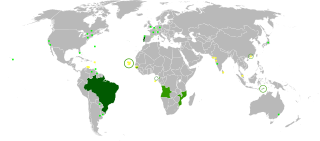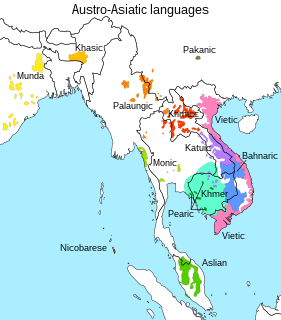
The phonology of Portuguese varies among dialects, in extreme cases leading to some difficulties in intelligibility. This article on phonology focuses on the pronunciations that are generally regarded as standard. Since Portuguese is a pluricentric language—and differences between European Portuguese (EP), Brazilian Portuguese (BP), and Angolan Portuguese (AP) can be considerable—varieties are distinguished whenever necessary.
Like many other languages, English has wide variation in pronunciation, both historically and from dialect to dialect. In general, however, the regional dialects of English share a largely similar phonological system. Among other things, most dialects have vowel reduction in unstressed syllables and a complex set of phonological features that distinguish fortis and lenis consonants.

The Muscogee language, also known as Creek, is a Muskogean language spoken by Muscogee (Creek) and Seminole people, primarily in the US states of Oklahoma and Florida. Along with Mikasuki, when it is spoken by the Seminole, it is known as Seminole.
French phonology is the sound system of French. This article discusses mainly the phonology of all the varieties of Standard French. Notable phonological features include its uvular r, nasal vowels, and three processes affecting word-final sounds:
Khmu[kʰmuʔ] is the language of the Khmu people of the northern Laos region. It is also spoken in adjacent areas of Vietnam, Thailand and China. Khmu lends its name to the Khmuic branch of the Austroasiatic language family, the latter of which also includes Khmer and Vietnamese. Within Austroasiatic, Khmu is often cited as being most closely related to the Palaungic and Khasic languages. The name "Khmu" can also be seen romanized as Kmhmu, Khmu', Kammu, or Khamuk in various publications or alternatively referred to by the name of a local dialect.

The Aslian languages are the southernmost branch of Austroasiatic languages spoken on the Malay Peninsula. They are the languages of many of the Orang Asli, the aboriginal inhabitants of the peninsula. The total number of native speakers of Aslian languages is about fifty thousand and all are in danger of extinction. Aslian languages recognized by the Malaysian administration include Kensiu, Kintaq, Jahai, Minriq, Batek, Cheq Wong, Lanoh, Temiar, Semai, Jah Hut, Mah Meri, Semaq Beri, Semelai and Temoq.
Mlabri is a language spoken by the Mlabri people in the border area between Thailand and Laos.
Semai is a Austroasiatic language of western Malaysia spoken by about 44,000 Semai people. It is one of the few Aslian language which is not endangered, and even has 2,000 monolingual speakers.
Chiripá Guarani, also known as Ava Guarani and Nhandéva (Ñandeva), is a Guaraní language spoken in Paraguay, Brazil, and also Argentina. Nhandéva is closely connected to Mbyá Guaraní, as intermarriage between speakers of the two languages is common. Speakers of Nhandéva and Mbyá generally live in mountainous areas of the Atlantic Forest, from eastern Paraguay through Misiones Province of Argentina to the southern Brazilian states of Paraná, Santa Catarina, and Rio Grande do Sul. There are approximately 4,900 speakers in Brazil and 7,000 in Paraguay.

The Mah Meri are an ethnic group native to western part of Peninsular Malaysia. They are one of the 18 Orang Asli groups named by the Malaysian government. They are of the Senoi subgroup. Most of the members of the Mah Meri tribe live along the coast of South Selangor from Sungai Pelek up to Pulau Carey, although there is at least one Mah Meri Community on the other side of the Klang River.
Gujarati is an Indo-Aryan language native to the Indian state of Gujarat. Much of its phonology is derived from Sanskrit.
The most thorough treatment of the Kiowa sound system is by Laurel Watkins in a generative framework. A consideration of prosodic phenomena with acoustic analysis is in Sivertsen (1956). Earlier discussions of phonemics are Trager (1960), Merrifield (1959), Wonderly et al. (1954), and Harrington (1928).

Mundari (Munɖari) is a Munda language of the Austroasiatic language family spoken by the Munda tribes in eastern Indian states of Jharkhand, Odisha and West Bengal. It is closely related to Santali. Mundari Bani, a script specifically to write Mundari, was invented by Rohidas Singh Nag. It has also been written in the Devanagari, Odia, Bengali, and Latin writing systems.
Bruu is a Mon–Khmer dialect continuum spoken by the Bru people of mainland Southeast Asia.
Pnar, also known as Jaiñtia, part of the Khasi language is an Austroasiatic language spoken in India and Bangladesh.
Kensiu (Kensiw) is an Austronesian language of the Jahaic subbranch. It is spoken by a small community of 300 in Yala Province in southern Thailand and also reportedly by a community of approximately 300 speakers in Western Malaysia in Perak and Kedah States. Speakers of this language are Negritos who are known as the Mani people or Maniq of Thailand.

Jah Hut is an Austroasiatic language spoken around the Krau river in peninsular Malaysia. The Jah Hut are one of the indigenous Orang Asli peoples.
Mah Meri, also known as Besisi, Cellate, Hma’ Btsisi’, Ma’ Betisek, and “Orang Sabat”, is an Austroasiatic language spoken in the Malay Peninsula. Along with Semaq Beri, Semelai and Temoq, Mah Meri belongs to the Southern Aslian branch of the Aslian languages. Mah Meri is the only remaining Aslian language spoken in a coastal area and its speaker population is 3,675 as recorded at the Orang Asli Museum in Gombak. A dictionary of the Mah Meri language has been compiled by Nicole Kruspe.
Temoq people belong to the Proto-Malay of the Orang Asli ethnic group that are found in Pahang, Malaysia.
Jedek is an Aslian language from the Austroasiatic family first reported in 2017. Jedek speakers describe themselves as ethnic Menriq or Batek to outsiders, but their language, although very closely related, is distinct from these languages.





